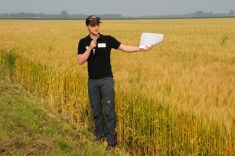Glacier FarmMedia – Canada’s soybean industry must navigate forks in the road.
During a late June meeting in Dauphin, Man., Soy Canada executive director Brian Innes told growers they should relish the options in front of them.
“Where do we want to go from here? The choice is ours,” he said several times.
Read Also

Manitoba boosts stake in cereals centre to $23.5 million
Premier Wab Kinew said the additional project funds will help ‘Trump-proof’ the provincial economy.
Innes cited the introduction of gene-editing technology, challenges of Canada’s typically lower-protein soybeans, opportunities in the food grade market and the need to have a strong voice for soy and work with other commodities.
Canada’s unusual soybean production breakdown — about 25 per cent is non-genetically modified and much goes to the human food market — has translated to industry fears that the benefits of gene editing in breeding will come slower to Canada than elsewhere.
The country has other advantages, however.
“Canada is better able to serve our customers who want the benefits of this tech with our world-class identity preserved system and our ability to maintain confidence across a variety of crops,” said Innes.
Farmers grumble about discounts on soybean crops due to a history of low protein compared to those from other exporters, but Innes said there are ways to address it. The industry can better explain Canadian soy’s unique protein composition and other elements. It can also use breeding to close the gaps.
“More consistent varieties that deliver more stable and high quality beans to our customers and farmers is possible,” Innes said.
Canadian food grade soybean producers and marketers also have choices to make about whether to focus on boosting the performance of individual companies or expand their share of the international marketplace.
Soy Canada is only 10 years old, formed when the industry realized it had to be treated independently of the pulse and special crops organizations in which it had traditionally resided.
The crop is not large compared to canola and wheat nationally, but in Manitoba it has become the province’s third-largest crop and it is also important in Ontario and Quebec. Farmers in Saskatchewan are keen to get into soybeans, but today’s varieties are still too fragile and long-seasoned to thrive in western Prairie conditions.
If variety development keeps adding toughness and shorter days to maturity, many expect to see western acres surge.
















